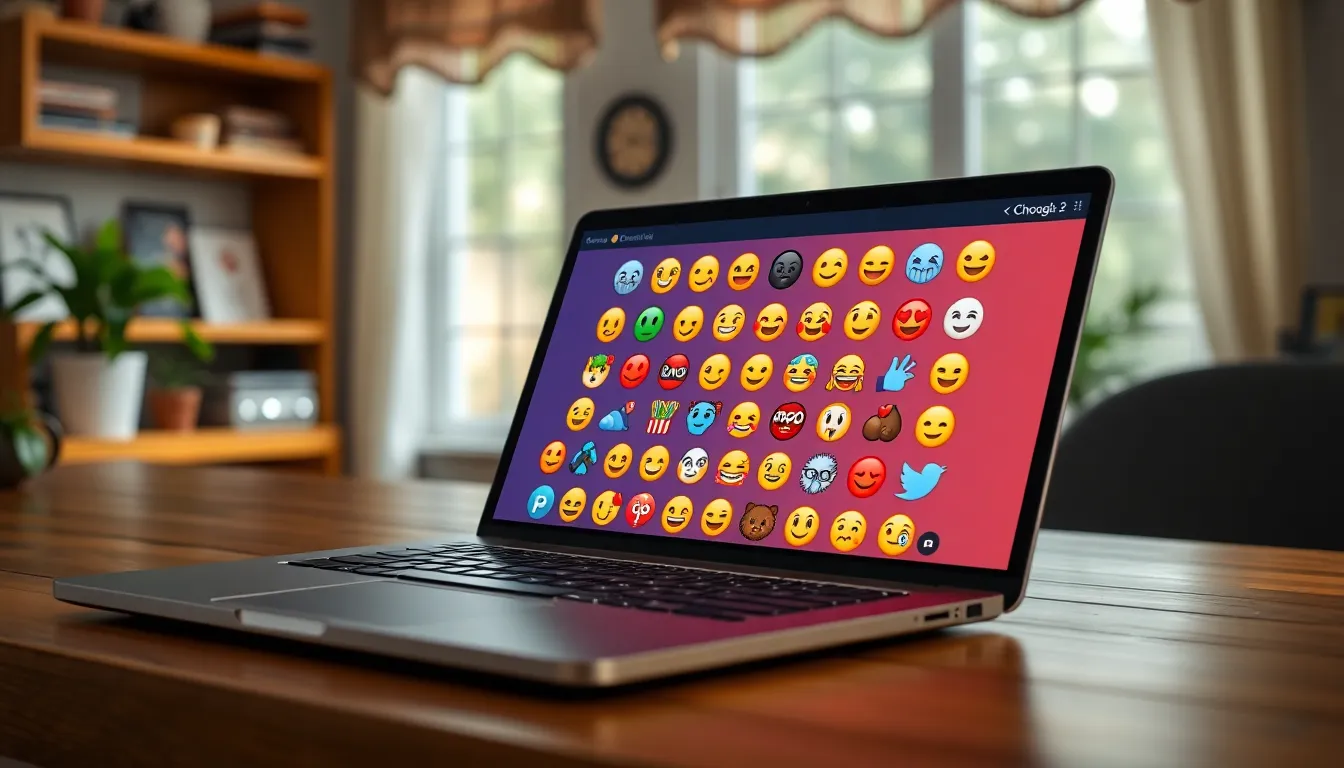Emojis have become a universal language, adding flair and emotion to digital communication. For Chromebook users, incorporating these fun symbols can enhance chats, emails, and social media posts. But how can one easily access and use emojis on a Chromebook?
Fortunately, the process is straightforward and user-friendly. With just a few simple steps, anyone can express themselves with a wide range of emojis. Whether it’s a smiley face to brighten someone’s day or a heart to show love, knowing how to put emojis on a Chromebook can make online interactions more engaging. Let’s dive into the easy methods that make emoji usage a breeze on this versatile device.
Table of Contents
ToggleUnderstanding Emojis on Chromebook
Emojis serve as visual representations of emotions and concepts, enhancing communication. Chromebook users benefit from built-in tools for easy emoji access. Here’s how to navigate emojis on a Chromebook effectively.
- Accessing the Emoji Keyboard
- Access the emoji keyboard by pressing
Search+Shift+Space. This keyboard simplifies the emoji selection process.
- Using the On-Screen Emoji Picker
- Use the on-screen emoji picker available in various applications. Click on the smiley face icon located in the text input area to view categories of emojis.
- Inserting Emojis via Keyboard Shortcuts
- Insert frequently used emojis using keyboard shortcuts. Typing
:smile:for a smiley face generates the corresponding emoji.
- Utilizing Apps for Emoji Support
- Utilize third-party apps available through the Chrome Web Store. Many apps offer enhanced emoji libraries and customization options.
- Copy-Pasting From Online Sources
- Copy emojis from websites dedicated to emoji libraries. These sources allow users to select and copy any emoji for use in their applications.
Utilizing these methods allows Chromebook users to enhance their online conversations, making them more expressive and engaging.
Using the Emoji Keyboard

Using the emoji keyboard on a Chromebook provides an easy way to express emotions and ideas in digital communication. This feature allows quick access to a vast array of emojis, enhancing conversations across various platforms.
Accessing the Emoji Keyboard
Chromebook users can access the emoji keyboard easily by pressing Search + Shift + Space. This combination opens the emoji picker, displaying a grid of available emojis. Users can also find shortcuts to frequently used emojis. Repeating frequently used emojis boosts efficiency in communication.
Navigating the Emoji Categories
The emoji picker features multiple categories, allowing users to navigate easily through different emoji groups. Categories include:
- Smileys & Emotion: Displays various facial expressions and feelings.
- People & Body: Shows emojis representing diverse individuals, body parts, and activities.
- Animals & Nature: Contains emojis related to both wildlife and natural elements.
- Food & Drink: Features different foods, beverages, and culinary items.
- Activities: Encompasses sports, hobbies, and various pastimes.
- Travel & Places: Illustrates modes of transportation and geographical locations.
- Objects: Displays everyday items, gadgets, and tools.
- Symbols: Includes various signs and symbols, such as a heart or a star.
Selecting any category narrows down the emoji options, making it easier for users to find the desired emoji for their conversations.
Inserting Emojis into Different Applications
Inserting emojis on a Chromebook varies by application. Below are methods for adding emojis in Google Docs and chat applications.
Adding Emojis in Google Docs
Emojis can enhance documents in Google Docs, making text more engaging. Users can follow these steps to add emojis:
- Open Google Docs. Start or select an existing document.
- Access the emoji keyboard. Press Search + Shift + Space to show the emoji picker.
- Select an emoji. Browse through categories or use the search bar to find a specific emoji. Click on the selected emoji to insert it into the document.
For frequent emoji users, Google Docs also supports keyboard shortcuts for quick access to commonly used emojis, enhancing productivity.
Using Emojis in Chat Apps
Using emojis in chat applications adds personality to conversations. Most chat platforms on Chromebooks support emoji insertion. Here’s how to incorporate emojis in popular chat apps:
- Launch the chat app. Open applications like Slack, Zoom, or Google Chat.
- Open the emoji picker. Use Search + Shift + Space to access the emoji keyboard.
- Insert an emoji. Scroll or search to find the desired emoji, then click to include it in the chat.
Additionally, users can explore each app’s specific emoji features, such as customizing responses or using emoji reactions, ensuring communications remain lively and expressive.
Customizing Emoji Preferences
Customizing emoji preferences on a Chromebook enhances user experience by tailoring the emoji input process. Users can adjust various settings to better suit personal communication styles.
- Access settings: Users must open the Chromebook settings by clicking the time in the bottom right corner, then selecting the gear icon.
- Keyboard settings: Users must navigate to the “Device” section, then choose “Keyboard.” Here, they can find options to modify their keyboard shortcuts for easier emoji access.
- Experiment with inputs: Users can try different input methods, such as the on-screen emoji picker or shortcut keys, to determine which works best for their typing habits.
- Explore third-party apps: Users might consider third-party emoji applications from the Chrome Web Store for additional customization. These apps often offer expanded libraries and unique emoji styles.
- Frequently used emojis: Users can take note of frequently used emojis and create a personal list. This can streamline the process of selecting the preferred emojis for quick access.
- Real-time updates: Users will receive automatic updates to the emoji library with each system update, ensuring access to the latest emojis and variations.
By customizing emoji preferences, Chromebook users enhance their digital communication, making it more engaging and personalized.
Troubleshooting Emoji Issues
Users may encounter several issues while using emojis on a Chromebook. Identifying and resolving these problems enhances overall communication and ensures a smoother experience.
- Missing Emoji Keyboard: If the emoji keyboard isn’t accessible, users should check accessibility settings. Verify that the keyboard shortcut for the emoji picker, Search + Shift + Space, is enabled.
- Emoji Not Displaying: For cases where emojis do not appear, users may need to update their Chrome OS. Install any available updates to ensure emoji compatibility, as system updates often include new emoji features.
- Third-Party App Issues: When using third-party emoji apps from the Chrome Web Store, users should ensure that the app is compatible with their version of Chrome OS. Incompatibility issues can prevent the app from functioning correctly.
- Slow Typing with Emoji: If typing slows down while using emojis, try disabling unnecessary extensions. Some extensions may interfere with performance. Reopening the browser can also help improve speed.
- Keyboard Shortcuts Not Working: Users should check for conflicting keyboard shortcuts. Other applications or settings may override the default emoji shortcut. Adjust or disable these settings accordingly to restore functionality.
- Inconsistent Emoji Styles: Emojis may appear differently across platforms due to variations in rendering. Use browser-based applications for a more consistent emoji style across devices.
- Accessing Emojis in Specific Apps: Certain applications may not support emojis fully. Check the specific app settings for emoji support options. Some messaging platforms may require enabling specific features for emoji access.
Following these troubleshooting steps allows users to maximize their emoji usage and maintain engaging communications on their Chromebook.
Emojis have become an essential part of digital communication for Chromebook users. By using the various methods outlined, anyone can easily enhance their messages and documents with expressive symbols.
Accessing the emoji keyboard and customizing preferences allows for a more personalized experience. With the right tools and shortcuts, users can navigate the vast array of emojis effortlessly.
Troubleshooting common issues ensures that the emoji experience remains smooth and enjoyable. Embracing emojis can truly transform online interactions, making them more engaging and visually appealing.






